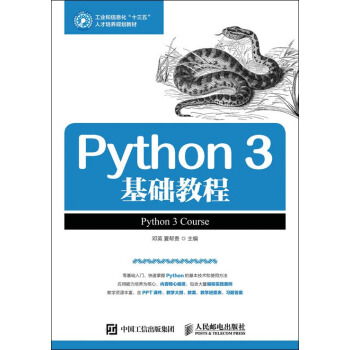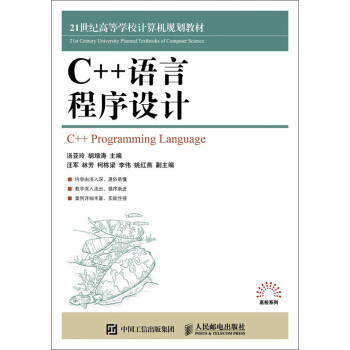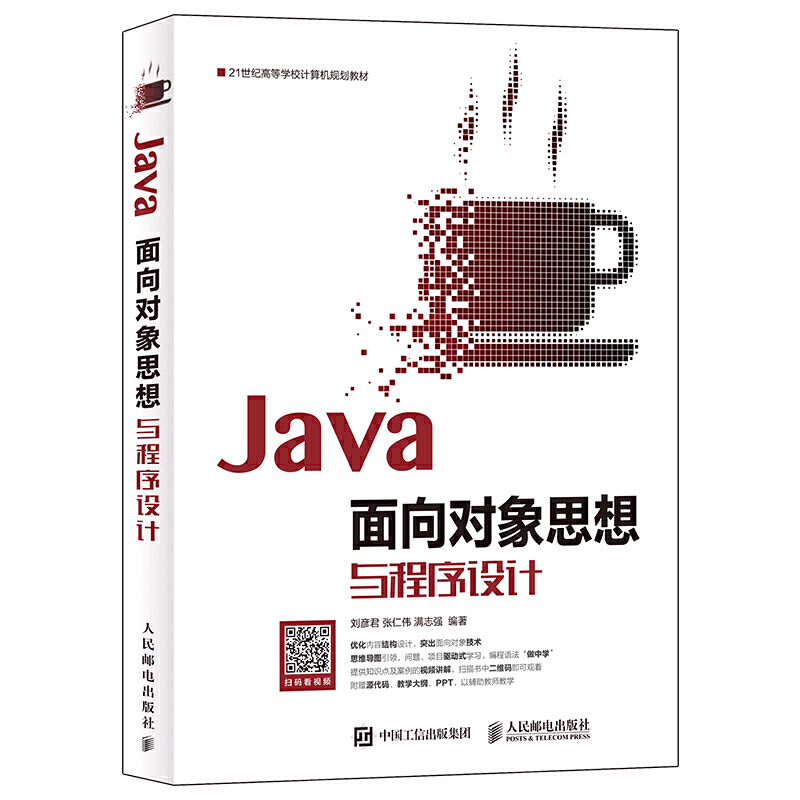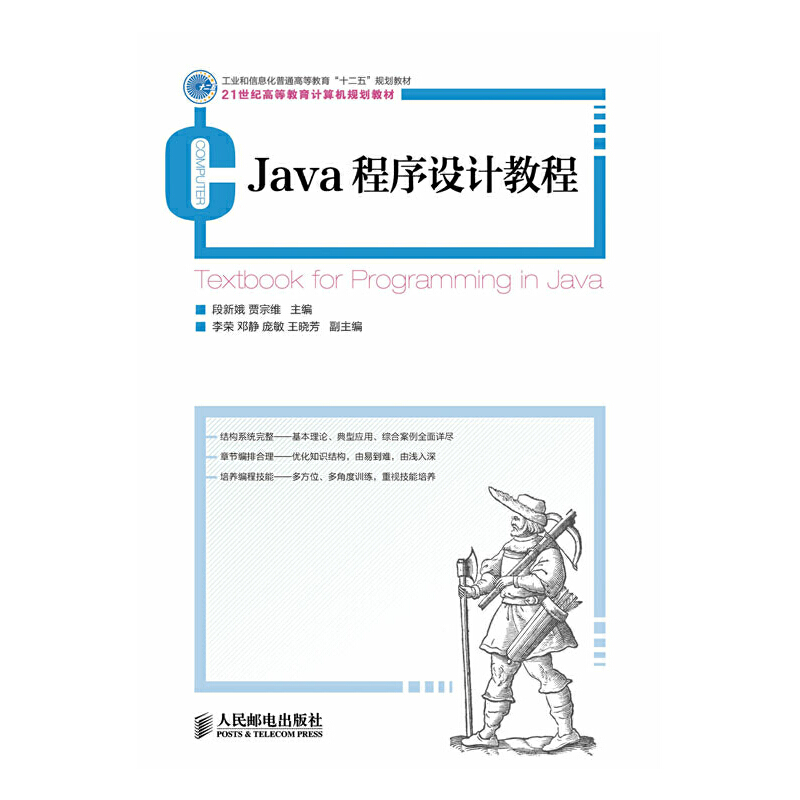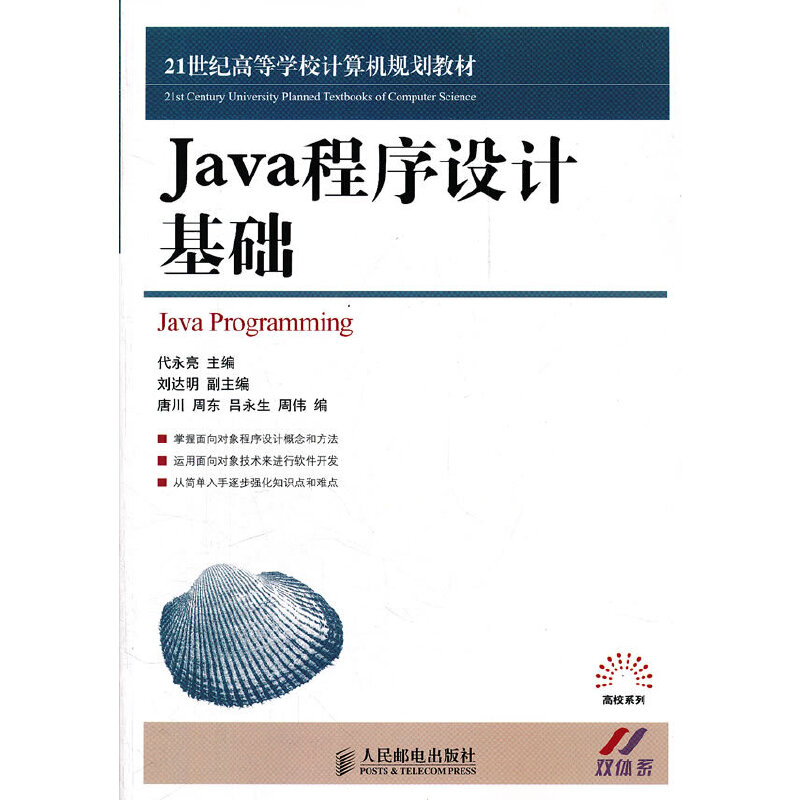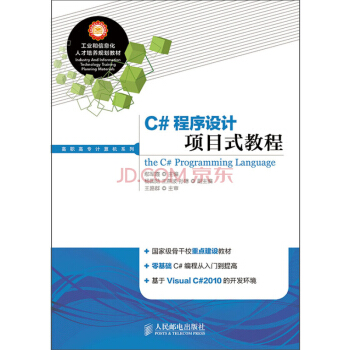Java核心技术
定价:¥109.00
作者: [美]霍斯特曼
出版时间:2016-06
出版社:人民邮电出版社
- 人民邮电出版社
- 9787115420114
- 72817
- 2016-06
- TP312
内容简介
霍斯特曼著的《Java核心技术(卷Ⅰ基础知识上下第10版英文版)》是经典的《Java核心技术 卷I:基础知识》的新版。这一版针对Java SE 8平台进行了全面更新,以反映Java SE 8的特性。
书中囊括了Java的全部基础知识,提供了大量完整且具有实际意义的应用示例,详细介绍了Java语言基础、面向对象编程、反射与代理、接口与内部类、事件监听器模型、使用Swing GUI工具进行图形用户界面程序设计、打包应用程序、异常处理、登录与调试、泛型编程、集合框架、多线程、并发等内容。
书中囊括了Java的全部基础知识,提供了大量完整且具有实际意义的应用示例,详细介绍了Java语言基础、面向对象编程、反射与代理、接口与内部类、事件监听器模型、使用Swing GUI工具进行图形用户界面程序设计、打包应用程序、异常处理、登录与调试、泛型编程、集合框架、多线程、并发等内容。
目录
Chapter 1: An Introduction to Java / Java概述
1.1 Java as a Programming Platform / Java程序设计平台
1.2 The Java“White Paper”Buzzwords / Java“白皮书”中的口号
1.2.1 Simple / 简单
1.2.2 Object-Oriented / 面向对象
1.2.3 Distributed / 分布式
1.2.4 Robust / 健壮
1.2.5 Secure / 安全
1.2.6 Architecture-Neutral / 体系结构中立
1.2.7 Portable / 可移植
1.2.8 Interpreted / 解释型
1.2.9 High-Performance / 高性能
1.2.10 Multithreaded / 多线程
1.2.11 Dynamic / 动态
1.3 Java Applets and the Internet / Java Applet与Int
1.4 A Short History of Java / Java简史
1.5 Common Misconceptions about Java / 对Java的常见误解
Chapter 2: The Java Programming Environment / Java编程环境
2.1 Installing the Java Development Kit / 安装Java开发包(JDK)
2.1.1 Downloading the JDK / 下?
2.1.2 Setting up the JDK / 设?
2.1.3 Installing Source Files and Documentation /源文件与文档的下载与设置
2.2 Using the Command-Line Tools / 使用命令行工具
2.3 Using an Integrated Development Environment / 使用集成开发环境
2.4 Running a Graphical Application / 运行图形化应用程序
2.5 Building and Running Applets / 构建并运行Ap
Chapter 3: Fundamental Programming Structures in Java / Java的基本编程结构
3.1 A Simple Java Program / 一个简单的Java程序
3.2 Comments / 注释
3.3 Data Types / 数据类型
3.3.1 Integer Types / 整型
3.3.2 Floating-Point Types / 浮点型
3.3.3 The char Type / char类型
3.3.4 Unicode and the char Type / Unicode与char类型
3.3.5 The boolean Type / boolean类型
3.4 Variables / 变量
3.4.1 Initializing Variables / 初始化变量
3.4.2 Constants / 常量
3.5 Operators / 运算符
3.5.1 Mathematical Functions and Constants / 数学函数与常量
3.5.2 Conversions between Numeric Types / 数值类型之间的转换
3.5.3 Casts / 强制类型转换
3.5.4 Combining Assignment with Operators / 组合赋值运算符
3.5.5 Increment and Decrement Operators / 自增运算符与自减运算符
3.5.6 Relational and Boolean Operators / 关系与boolean运算符
3.5.7 Bitwise Operators / 位运算符
3.5.8 Parentheses and Operator Hierarchy / 括号与运算符优先级
3.5.9 Enumerated Types / 枚举类型
3.6 Strings / 字符串
3.6.1 Substrings / 子串
3.6.2 Concatenation / 拼接
3.6.3 Strings Are Immutable / String是不可变的
3.6.4 Testing Strings for Equality / 测试字符串是否相等
3.6.5 Empty and Null Strings / 空串与null串
3.6.6 Code Points and Code Units / 码位与编码单元
3.6.7 The String API / String 类?
3.6.8 Reading the Online API Documentation / 阅读在线API文档
3.6.9 Building Strings / 构建字符串
3.7 Input and Output / 输入输出
3.7.1 Reading Input / 读取输入
3.7.2 Formatting Output / 格式化输出
3.7.3 File Input and Output / 文件输入输出
3.8 Control Flow / 控制流
3.8.1 Block Scope / 块作用域
3.8.2 Conditional Statements / 条件语句
3.8.3 Loops / 循环
3.8.4 Determinate Loops / 确定性循环
3.8.5 Multiple Selections—The switch Statement / 多重选择:switch语句
3.8.6 Statements That Break Control Flow / 用于跳出控制流的语句
3.9 Big Numbers / 大数
3.10 Arrays / 数组
3.10.1 The “for each” Loop / “for each”循环
3.10.2 Array Initializers and Anonymous Arrays / 数组初始化与匿名数组
3.10.3 Array Copying / 数组复制
3.10.4 Command-Line Parameters / 命令行参数
3.10.5 Array Sorting / 数组排序
3.10.6 Multidimensional Arrays / 多维数组
3.10.7 Ragged Arrays / 不规则数组
Chapter 4: Objects and Classes /对象与类
4.1 Introduction to Object-Oriented Programming / 面向对象编程简介
4.1.1 Classes / 类
4.1.2 Objects / 对象
4.1.3 Identifying Classes / 识别类
4.1.4 Relationships between Classes / 类之间的关系
4.2 Using Predefined Classes / 使用预定义类
4.2.1 Objects and Object Variables / 对象与对象变量
4.2.2 The LocalDate Class of the Java Library / Java 库中的LocalDate类
4.2.3 Mutator and Accessor Methods / 更改器方法与访问器方法
4.3 Defining Your Own Classes / 定义自己的类
4.3.1 An Employee Class / Employee类
4.3.2 Use of Multiple Source Files / 使用多个源文件
4.3.3 Dissecting the Employee Class / 分析Employee类
4.3.4 First Steps with Constructors / 从构造器开始
4.3.5 Implicit and Explicit Parameters / 隐式参数与显式参数
4.3.6 Benefits of Encapsulation / 封装的好处
4.3.7 Class-Based Access Privileges / 基于类的访问权限
4.3.8 Private Methods / 私有方法
4.3.9 Final Instance Fields / final实例字段
4.4 Static Fields and Methods / 静态字段与静态方法
4.4.1 Static Fields / 静态字段
4.4.2 Static Constants / 静态常量
4.4.3 Static Methods / 静态方法
4.4.4 Factory Methods / 工厂方法
4.4.5 The main Method / main方法
4.5 Method Parameters / 方法参数
4.6 Object Construction / 对象构建
4.6.1 Overloading / 重载
4.6.2 Default Field Initialization / 默认字段初始化
4.6.3 The Constructor with No Arguments / 无参构造器
4.6.4 Explicit Field Initialization / 显式字段初始化
4.6.5 Parameter Names / 参数名
4.6.6 Calling Another Constructor / 调用另一个构造器
4.6.7 Initialization Blocks / 初始化块
4.6.8 Object Destruction and the finalize Method / 对象析构与finalize方法
4.7 Packages / 包
4.7.1 Class Importation / 导入类
4.7.2 Static Imports / 静态导入
4.7.3 Addition of a Class into a Package / 将类添加到某个包中
4.7.4 Package Scope / 包作用域
4.8 The Class Path / 类路径
4.8.1 Setting the Class Path / 设置类路径
4.9 Documentation Comments / 文档注释
4.9.1 Comment Insertion / 插入注释
4.9.2 Class Comments / 类注释
4.9.3 Method Comments / 方法注释
4.9.4 Field Comments / 字段注释
4.9.5 General Comments / 通用注释
4.9.6 Package and Overview Comments / 包与概述注释
4.9.7 Comment Extraction / 提取注释
4.10 Class Design Hints / 类设计建议
Chapter 5: Inheritance / 继承
5.1 Classes, Superclasses, and Subclasses / 类、超类与子类
5.1.1 Defining Subclasses / 定义子类
5.1.2 Overriding Methods / 覆盖方法
5.1.3 Subclass Constructors / 子类构造器
5.1.4 Inheritance Hierarchies / 继承层次
5.1.5 Polymorphism / 多态
5.1.6 Understanding Method Calls / 理解方法调用
5.1.7 Preventing Inheritance: Final Classes and Methods / 阻止继承:final修饰的类和方法
5.1.8 Casting / 强制类型转换
5.1.9 Abstract Classes / 抽象类
5.1.10 Protected Access / 受保护访问
5.2 Object: The Cosmic Superclass / Object:所有类的超类
5.2.1 The equals Method / equals方法
5.2.2 Equality Testing and Inheritance / 相等测试与继承
5.2.3 The hashCode Method / hashCode方法
5.2.4 The toString Method / toString方法
5.3 Generic Array Lists / 泛型数组列表
5.3.1 Accessing Array List Elements / 访问泛型数组列表的元素
5.3.2 Compatibility between Typed and Raw Array Lists / 泛型数组列表与原始数组列表的兼容性
5.4 Object Wrappers and Autoboxing / 对象包装器与自动装箱
5.5 Methods with a Variable Number of Parameters / 参数数量可变的方法
5.6 Enumeration Classes / 枚举类
5.7 Reflection / 反射
5.7.1 The Class Class / Class类
5.7.2 A Primer on Catching Exceptions / 捕获异常简介
5.7.3 Using Reflection to Analyze the Capabilities of Classes / 使用反射分析类的能力
5.7.4 Using Reflection to Analyze Objects at Runtime / 在运行时使用反射分析对象
5.7.5 Using Reflection to Write Generic Array Code / 使用反射编写泛型数组代码
5.7.6 Invoking Arbitrary Methods / 调用任意方法
5.8 Design Hints for Inheritance / 继承的设计建议
Chapter 6: Interfaces, Lambda Expressions, and Inner Classes / 接口、Lambda表达式和内部类
6.1 Interfaces / 接口
6.1.1 The Interface Concept / 接口的概念
6.1.2 Properties of Interfaces / 接口的特性
6.1.3 Interfaces and Abstract Classes / 接口与抽象类
6.1.4 Static Methods / 静态方法
6.1.5 Default Methods / 默认方法
6.1.6 Resolving Default Method Conflicts / 解决默认方法的冲突
6.2 Examples of Interfaces / 接口示例
6.2.1 Interfaces and Callbacks / 接口与回调
6.2.2 The Comparator Interface / Comparator接口
6.2.3 Object Cloning / 对象克隆
6.3 Lambda Expressions / Lambda表达式
6.3.1 Why Lambdas? / 为什么引入Lambda表达式
6.3.2 The Syntax of Lambda Expressions / Lambda表达式的语法
6.3.3 Functional Interfaces / 函数式接口
6.3.4 Method References / 方法引用
6.3.5 Constructor References / 构造器引用
6.3.6 Variable Scope / 变量作用域
6.3.7 Processing Lambda Expressions / 处理Lambda表达式
6.3.8 More about Comparators / 再谈Compara
6.4 Inner Classes / 内部类
6.4.1 Use of an Inner Class to Access Object State / 使用内部类访问对象状态
6.4.2 Spe Syntax Rules for Inner Classes / 内部类的特殊语法规则
6.4.3 Are Inner Classes Useful? Actually Necessary? Secure? / 内部类是否有用、必要和安全
6.4.4 Local Inner Classes / 局部内部类
6.4.5 Accessing Variables from Outer Methods / 从外部方法访问变量
6.4.6 Anonymous Inner Classes / 匿名内部类
6.4.7 Static Inner Classes / 静态内部类
6.5 Proxies / 代理
6.5.1 When to Use Proxies / 何时使用代理
6.5.2 Creating Proxy Objects / 创建代理对象
6.5.3 Properties of Proxy Classes / 代理类的特性
Chapter 7: Exceptions, Assertions, and Logging /异常、断言与日志
7.1 Dealing with Errors / 处理错误
7.1.1 The Classification of Exceptions / 异常分类
7.1.2 Declaring Checked Exceptions / 声明检查型异常
7.1.3 How to Throw an Exception / 如何抛出异常
7.1.4 Creating Exception Classes / 创建异常类
7.2 Catching Exceptions / 捕获异常
7.2.1 Catching an Exception / 捕获一个异常
7.2.2 Catching Multiple Exceptions / 捕获多个异常
7.2.3 Rethrowing and Chaining Exceptions / 再次抛出异常与异常链
7.2.4 The finally Clause / finally子句
7.2.5 The Try-with-Resources Statement / try-with-resources语句
7.2.6 Analyzing Stack Trace Elements / 分析栈轨迹元素
7.3 Tips for Using Exceptions / 异常使用技巧
7.4 Using Assertions / 使用断言
7.4.1 The Assertion Concept / 断言的概念
7.4.2 Assertion Enabling and Disabling / 启用和禁用断言
7.4.3 Using Assertions for Parameter Checking / 使用断言检查参数
7.4.4 Using Assertions for Documenting Assumptions / 使用断言保证文档中假定成立的条件
7.5 Logging / 日志
7.5.1 Basic Logging / 基本日志
7.5.2 Advanced Logging / 高级日志
7.5.3 Changing the Log Manager Configuration / 修改日志管理器配置
7.5.4 Localization / 本地化
7.5.5 Handlers / 处理器
7.5.6 Filters / 过滤器
7.5.7 Formatters / 格式化器
7.5.8 A Logging Recipe / 常见日志操作总结
7.6 Debugging Tips / 调试技巧
Chapter 8: Generic Programming /泛型编程
8.1 Why Generic Programming? / 为什么要使用泛型编程
8.1.1 The Advantage of Type Parameters / 类型参数的好处
8.1.2 Who Wants to Be a Generic Programmer? / 哪些人想成为泛型程序员
8.2 Defining a Simple Generic Class / 定义简单的泛型类
8.3 Generic Methods / 泛型方法
8.4 Bounds for Type Variables / 类型变量的绑定
8.5 Generic Code and the Virtual Machine / 泛型代码与虚拟机
8.5.1 Type Erasure / 类型擦除
8.5.2 Translating Generic Expressions / 翻译泛型表达式
8.5.3 Translating Generic Methods / 翻译泛型方法
8.5.4 Calling Legacy Code / 调用遗留代码
8.6 Restrictions and Limitations / 约束与局限性
8.6.1 Type Parameters Cannot Be Instantiated with Primitive Types / 类型参数不能用基本类型来实例化
8.6.2 Runtime Type Inquiry Only Works with Raw Types / 运行时类型查询只适用于原始类型
8.6.3 You Cannot Create Arrays of Parameterized Types / 不能创建参数化类型的数组
8.6.4 Varargs Warnings / 注意变长参数情况
8.6.5 You Cannot Instantiate Type Variables / 不能实例化类型变量
8.6.6 You Cannot Construct a Generic Array / 不能构造泛型数组
8.6.7 Type Variables Are Not Valid in Static Contexts of Generic Classes / 类型变量在泛型类的静态上下文中无效
8.6.8 You Cannot Throw or Catch Instances of a Generic Class / 不能抛出或捕获泛型类的实例
8.6.9 You Can Defeat Checked Exception Checking / 可以打破“检查型异常必须检查”的规则
8.6.10 Beware of Clashes after Erasure / 注意类型擦除后的冲突
8.7 Inheritance Rules for Generic Types / 泛型类型的继承规则
8.8 Wildcard Types / 通配符类型
8.8.1 The Wildcard Concept / 通配符的概念
8.8.2 Supertype Bounds for Wildcards / 通配符的超类型限定
8.8.3 Unbounded Wildcards / 无限定通配符
8.8.4 Wildcard Capture / 通配符捕获
8.9 Reflection and Generics / 反射与泛型
8.9.1 The Generic Class Class / 泛型的Class类
8.9.2 Using Class Parameters for Type Matching / 使用Class参数进行类型匹配
8.9.3 Generic Type Information in the Virtual Machine / 虚拟机中的泛型类型信息
Chapter 9: Collections /集合类
9.1 The Java Collections Framework / Java 集合类框架
9.1.1 Separating Collection Interfaces and Implementation / 将集合类的接口与实现分离
9.1.2 The Collection Interface / Collection接口
9.1.3 Iterators / 迭代器
9.1.4 Generic Utility Methods / 泛型的实用方法
9.1.5 Interfaces in the Collections Framework / 集合类框架中的接口
9.2 Concrete Collections / 具体的集合类
9.2.1 Linked Lists / 链表
9.2.2 Array Lists / 数组列表
9.2.3 Hash Sets / 散列集
9.2.4 Tree Sets / 树形集
9.2.5 Queues and Deques / 队列与双端队列
9.2.6 Priority Queues / 优先级队列
9.3 Maps / 映射
9.3.1 Basic Map Operations / 基本映射操作
9.3.2 Updating Map Entries / 更新映射表项
9.3.3 Map Views / 映射视图
9.3.4 Weak Hash Maps / 弱散列映射
9.3.5 Linked Hash Sets and Maps / LinkedHashSet与LinkedHash
9.3.6 Enumeration Sets and Maps / EnumSet与Enum
9.3.7 Identity Hash Maps / IdentityHash
9.4 Views and Wrappers / 视图与包装器
9.4.1 Lightweight Collection Wrappers / 轻量级集合包装器
9.4.2 Subranges / 子范围
9.4.3 Unmodifiable Views / 不可修改视图
9.4.4 Synchronized Views / 同步视图
9.4.5 Checked Views / 检查用视图
9.4.6 A Note on Optional Operations / 可选操作说明
9.5 Algorithms / 算法
9.5.1 Sorting and Shuffiing / 排序与混排
9.5.2 Binary Search / 二分查找
9.5.3 Simple Algorithms / 简单算法
9.5.4 Bulk Operations / 主要操作
9.5.5 Converting between Collections and Arrays / 集合与数组之间的转换
9.5.6 Writing Your Own Algorithms / 编写自己的算法
9.6 Legacy Collections / 遗留的集合类
9.6.1 The Hashtable Class / Hashtable类
9.6.2 Enumerations / Enumerat
9.6.3 Property Maps / 属性映射
9.6.4 Stacks / 栈
9.6.5 Bit Sets / 位集
Chapter 10: Graphics Programming /图形界面编程
10.1 Introducing Swing / Swing简介
10.2 Creating a Frame / 创建框架
10.3 Positioning a Frame / 设定框架的显示位置
10.3.1 Frame Properties / 框架属性
10.3.2 Determining a Good Frame Size / 确定合适的框架大小
10.4 Displaying Information in a Component / 在组件中显示信息
10.5 Working with 2D Shapes / 处理2D图形
10.6 Using Color / 使用颜色
10.7 Using Spe Fonts for Text / 使用特殊的文本字体
10.8 Displaying Images / 显示图片
Chapter 11: Event Handling /事件处理
11.1 Basics of Event Handling / 事件处理基础
11.1.1 Example: Handling a Button Click / 示例:处理按钮点击事件
11.1.2 Specifying Listeners Concisely / 设置监听器的简洁方法
11.1.3 Example: Changing the Look-and-Feel / 示例:修改观感
11.1.4 Adapter Classes / 适配器类
11.2 Actions / 动作
11.3 Mouse Events / 鼠标事件
11.4 The AWT Event Hierarchy / AWT事件层次
11.4.1 Semantic and Low-Level Events / 语义与底层事件
Chapter 12: User Interface Components with Swing / Swing用户界面组件
12.1 Swing and the Model-View-Controller Design Pattern / Swing与模型-视图-控制器设计模式
12.1.1 Design Patterns / 设计模式
12.1.2 The Model-View-Controller Pattern / 模型-视图-控制器模式
12.1.3 A Model-View-Controller Analysis of Swing Buttons / Swing按钮的模型-视图-控制器分析
12.2 Introduction to Layout Management / 布局管理简介
12.2.1 Border Layout / 边框布局
12.2.2 Grid Layout / 网格布局
12.3 Text Input / 文本输入
12.3.1 Text Fields / 文本框
12.3.2 Labels and Labeling Components / 标签与标签组件
12.3.3 Password Fields / 密码框
12.3.4 Text Areas / 文本区域
12.3.5 Scroll Panes / 滚动窗格
12.4 Choice Components / 选择组件
12.4.1 Checkboxes / 复选框
12.4.2 Radio Buttons / 单选按钮
12.4.3 Borders / 边框
12.4.4 Combo Boxes / 组合框
12.4.5 Sliders / 滑动条
12.5 Menus / 菜单
12.5.1 Menu Building / 菜单构建
12.5.2 Icons in Menu Items / 菜单项中的图标
12.5.3 Checkbox and Radio Button Menu Items / 复选框和单选按钮菜单项
12.5.4 Pop-Up Menus / 弹出菜单
12.5.5 Keyboard Mnemonics and Accelerators / 键盘助记符与快捷键
12.5.6 Enabling and Disabling Menu Items / 启用和禁用菜单项
12.5.7 Toolbars / 工具栏
12.5.8 Tooltips / 工具提示
12.6 Sophisticated Layout Management / 复杂的布局管理
12.6.1 The Grid Bag Layout / 网格布局管理
12.6.2 Group Layout / 组布局
12.6.3 Using No Layout Manager / 不使用布局管理器
12.6.4 Custom Layout Managers / 定制布局管理器
12.6.5 Traversal Order / 遍历顺序
12.7 Dialog Boxes / 对话框
12.7.1 Option Dialogs / 选项对话框
12.7.2 Creating Dialogs / 创建对话框
12.7.3 Data Exchange / 数据交换
12.7.4 File Dialogs / 文件对话框
12.7.5 Color Choosers / 颜色选择器
12.8 Troubleshooting GUI Programs / GUI程序的问题定位
12.8.1 Debugging Tips / 调试技巧
12.8.2 Letting the AWT Robot Do the Work / 把工作交给AWT Ro
Chapter 13: Deploying Java Applications / 部署Java应用程序
13.1 JAR Files / JAR文件
13.1.1 Creating JARfiles / 创建JAR文件
13.1.2 The Manifest / 清单文件
13.1.3 Executable JAR Files / 可执行的JAR文件
13.1.4 Resources / 资源
13.1.5 Sealing / 封闭
13.2 Storage of Application Preferences / 应用偏好信息的存储
13.2.1 Property Maps / 属性映射
13.2.2 The Preferences API / Properties
13.3 Service Loaders / 服务加载器
13.4 Applets / App
13.4.1 A Simple Applet / 一个简单的App
13.4.2 The applet HTML Tag and Its Attributes / applet HTML标记及其属性
13.4.3 Use of Parameters to Pass Information to Applets / 使用参数向Applet传递信息
13.4.4 Accessing Image and Audio Files / 访问图片和音频文件
13.4.5 The Applet Context / Applet上下文
13.4.6 Inter-Applet Communication / Applet间的通信
13.4.7 Displaying Items in the Browser / 在浏览器中显示信息
13.4.8 The Sandbox / 沙箱
13.4.9 Signed Code / 签名代码
13.5 Java Web Start / Java Web St
13.5.1 Delivering a Java Web Start Application / 交付一个Java Web Start应用
13.5.2 The JNLP API / JNLP
Chapter 14: Concurrency /并发
14.1 What Are Threads? / 什么是线程
14.1.1 Using Threads to Give Other Tasks a Chance / 使用线程为其他任务提供执行机会
14.2 Interrupting Threads / 中断线程
14.3 Thread States / 线程状态
14.3.1 New Threads / 新创建线程
14.3.2 Runnable Threads / 可运行线程
14.3.3 Blocked and Waiting Threads / 被阻塞线程与等待线程
14.3.4 Terminated Threads / 被终止的线程
14.4 Thread Properties / 线程属性
14.4.1 Thread Priorities / 线程优先级
14.4.2 Daemon Threads / 守护线程
14.4.3 Handlers for Uncaught Exceptions / 未捕获异常的处理器
14.5 Synchronization / 同步
14.5.1 An Example of a Race Condition / 竞争条件的一个案例
14.5.2 The Race Condition Explained / 竞争条件详解
14.5.3 Lock Objects / 锁对象
14.5.4 Condition Objects / 条件对象
14.5.5 The synchronized Keyword / synchronized关键字
14.5.6 Synchronized Blocks / 同步块
14.5.7 The Monitor Concept / 监视器概念
14.5.8 Volatile Fields / volatile字段
14.5.9 Final Variables / final变量
14.5.10 Atomics / 原子
14.5.11 Deadlocks / 死锁
14.5.12 Thread-Local Variables / 线程局部变量
14.5.13 Lock Testing and Timeouts / 锁测试与超时
14.5.14 Read / Write Locks / 读/写锁
14.5.15 Why the stop and suspend Methods Are Deprecated / 为什么弃用stop和suspend方法
14.6 Blocking Queues / 阻塞队列
14.7 Thread-Safe Collections / 线程安全的集合
14.7.1 Efficient Maps, Sets, and Queues / 高效的映射、集和队列
14.7.2 Atomic Update of Map Entries / 映射表项的原子更新
14.7.3 Bulk Operations on Concurrent Hash Maps / 并发散列映射上的主要操作
14.7.4 Concurrent Set Views / 并发的集视图
14.7.5 Copy on Write Arrays / 写时复制的数组
14.7.6 Parallel Array Algorithms / 并行数组算法
14.7.7 Older Thread-Safe Collections / 较早的线程安全的集合
14.8 Callables and Futures / Callable与Fut
14.9 Executors / 执行器
14.9.1 Thread Pools / 线程池
14.9.2 Scheduled Execution / 预订执行
14.9.3 Controlling Groups of Tasks / 控制任务组
14.9.4 The Fork-Join Framework / Fork-Join框架
14.9.5 Completable Futures / CompletableFut
14.10 Synchronizers / 同步器
14.10.1 Semaphores / 信号量
14.10.2 Countdown Latches / 倒计时门栓
14.10.3 Barriers / 障栅
14.10.4 Exchangers / 交换器
14.10.5 Synchronous Queues / 同步队列
14.11 Threads and Swing / 线程与Sw
14.11.1 Running Time-Consuming Tasks / 运行耗时任务
14.11.2 Using the Swing Worker / 使用Swing工作线程
14.11.3 The Single-Thread Rule / 单线程规则
Appendix / 附录
1.1 Java as a Programming Platform / Java程序设计平台
1.2 The Java“White Paper”Buzzwords / Java“白皮书”中的口号
1.2.1 Simple / 简单
1.2.2 Object-Oriented / 面向对象
1.2.3 Distributed / 分布式
1.2.4 Robust / 健壮
1.2.5 Secure / 安全
1.2.6 Architecture-Neutral / 体系结构中立
1.2.7 Portable / 可移植
1.2.8 Interpreted / 解释型
1.2.9 High-Performance / 高性能
1.2.10 Multithreaded / 多线程
1.2.11 Dynamic / 动态
1.3 Java Applets and the Internet / Java Applet与Int
1.4 A Short History of Java / Java简史
1.5 Common Misconceptions about Java / 对Java的常见误解
Chapter 2: The Java Programming Environment / Java编程环境
2.1 Installing the Java Development Kit / 安装Java开发包(JDK)
2.1.1 Downloading the JDK / 下?
2.1.2 Setting up the JDK / 设?
2.1.3 Installing Source Files and Documentation /源文件与文档的下载与设置
2.2 Using the Command-Line Tools / 使用命令行工具
2.3 Using an Integrated Development Environment / 使用集成开发环境
2.4 Running a Graphical Application / 运行图形化应用程序
2.5 Building and Running Applets / 构建并运行Ap
Chapter 3: Fundamental Programming Structures in Java / Java的基本编程结构
3.1 A Simple Java Program / 一个简单的Java程序
3.2 Comments / 注释
3.3 Data Types / 数据类型
3.3.1 Integer Types / 整型
3.3.2 Floating-Point Types / 浮点型
3.3.3 The char Type / char类型
3.3.4 Unicode and the char Type / Unicode与char类型
3.3.5 The boolean Type / boolean类型
3.4 Variables / 变量
3.4.1 Initializing Variables / 初始化变量
3.4.2 Constants / 常量
3.5 Operators / 运算符
3.5.1 Mathematical Functions and Constants / 数学函数与常量
3.5.2 Conversions between Numeric Types / 数值类型之间的转换
3.5.3 Casts / 强制类型转换
3.5.4 Combining Assignment with Operators / 组合赋值运算符
3.5.5 Increment and Decrement Operators / 自增运算符与自减运算符
3.5.6 Relational and Boolean Operators / 关系与boolean运算符
3.5.7 Bitwise Operators / 位运算符
3.5.8 Parentheses and Operator Hierarchy / 括号与运算符优先级
3.5.9 Enumerated Types / 枚举类型
3.6 Strings / 字符串
3.6.1 Substrings / 子串
3.6.2 Concatenation / 拼接
3.6.3 Strings Are Immutable / String是不可变的
3.6.4 Testing Strings for Equality / 测试字符串是否相等
3.6.5 Empty and Null Strings / 空串与null串
3.6.6 Code Points and Code Units / 码位与编码单元
3.6.7 The String API / String 类?
3.6.8 Reading the Online API Documentation / 阅读在线API文档
3.6.9 Building Strings / 构建字符串
3.7 Input and Output / 输入输出
3.7.1 Reading Input / 读取输入
3.7.2 Formatting Output / 格式化输出
3.7.3 File Input and Output / 文件输入输出
3.8 Control Flow / 控制流
3.8.1 Block Scope / 块作用域
3.8.2 Conditional Statements / 条件语句
3.8.3 Loops / 循环
3.8.4 Determinate Loops / 确定性循环
3.8.5 Multiple Selections—The switch Statement / 多重选择:switch语句
3.8.6 Statements That Break Control Flow / 用于跳出控制流的语句
3.9 Big Numbers / 大数
3.10 Arrays / 数组
3.10.1 The “for each” Loop / “for each”循环
3.10.2 Array Initializers and Anonymous Arrays / 数组初始化与匿名数组
3.10.3 Array Copying / 数组复制
3.10.4 Command-Line Parameters / 命令行参数
3.10.5 Array Sorting / 数组排序
3.10.6 Multidimensional Arrays / 多维数组
3.10.7 Ragged Arrays / 不规则数组
Chapter 4: Objects and Classes /对象与类
4.1 Introduction to Object-Oriented Programming / 面向对象编程简介
4.1.1 Classes / 类
4.1.2 Objects / 对象
4.1.3 Identifying Classes / 识别类
4.1.4 Relationships between Classes / 类之间的关系
4.2 Using Predefined Classes / 使用预定义类
4.2.1 Objects and Object Variables / 对象与对象变量
4.2.2 The LocalDate Class of the Java Library / Java 库中的LocalDate类
4.2.3 Mutator and Accessor Methods / 更改器方法与访问器方法
4.3 Defining Your Own Classes / 定义自己的类
4.3.1 An Employee Class / Employee类
4.3.2 Use of Multiple Source Files / 使用多个源文件
4.3.3 Dissecting the Employee Class / 分析Employee类
4.3.4 First Steps with Constructors / 从构造器开始
4.3.5 Implicit and Explicit Parameters / 隐式参数与显式参数
4.3.6 Benefits of Encapsulation / 封装的好处
4.3.7 Class-Based Access Privileges / 基于类的访问权限
4.3.8 Private Methods / 私有方法
4.3.9 Final Instance Fields / final实例字段
4.4 Static Fields and Methods / 静态字段与静态方法
4.4.1 Static Fields / 静态字段
4.4.2 Static Constants / 静态常量
4.4.3 Static Methods / 静态方法
4.4.4 Factory Methods / 工厂方法
4.4.5 The main Method / main方法
4.5 Method Parameters / 方法参数
4.6 Object Construction / 对象构建
4.6.1 Overloading / 重载
4.6.2 Default Field Initialization / 默认字段初始化
4.6.3 The Constructor with No Arguments / 无参构造器
4.6.4 Explicit Field Initialization / 显式字段初始化
4.6.5 Parameter Names / 参数名
4.6.6 Calling Another Constructor / 调用另一个构造器
4.6.7 Initialization Blocks / 初始化块
4.6.8 Object Destruction and the finalize Method / 对象析构与finalize方法
4.7 Packages / 包
4.7.1 Class Importation / 导入类
4.7.2 Static Imports / 静态导入
4.7.3 Addition of a Class into a Package / 将类添加到某个包中
4.7.4 Package Scope / 包作用域
4.8 The Class Path / 类路径
4.8.1 Setting the Class Path / 设置类路径
4.9 Documentation Comments / 文档注释
4.9.1 Comment Insertion / 插入注释
4.9.2 Class Comments / 类注释
4.9.3 Method Comments / 方法注释
4.9.4 Field Comments / 字段注释
4.9.5 General Comments / 通用注释
4.9.6 Package and Overview Comments / 包与概述注释
4.9.7 Comment Extraction / 提取注释
4.10 Class Design Hints / 类设计建议
Chapter 5: Inheritance / 继承
5.1 Classes, Superclasses, and Subclasses / 类、超类与子类
5.1.1 Defining Subclasses / 定义子类
5.1.2 Overriding Methods / 覆盖方法
5.1.3 Subclass Constructors / 子类构造器
5.1.4 Inheritance Hierarchies / 继承层次
5.1.5 Polymorphism / 多态
5.1.6 Understanding Method Calls / 理解方法调用
5.1.7 Preventing Inheritance: Final Classes and Methods / 阻止继承:final修饰的类和方法
5.1.8 Casting / 强制类型转换
5.1.9 Abstract Classes / 抽象类
5.1.10 Protected Access / 受保护访问
5.2 Object: The Cosmic Superclass / Object:所有类的超类
5.2.1 The equals Method / equals方法
5.2.2 Equality Testing and Inheritance / 相等测试与继承
5.2.3 The hashCode Method / hashCode方法
5.2.4 The toString Method / toString方法
5.3 Generic Array Lists / 泛型数组列表
5.3.1 Accessing Array List Elements / 访问泛型数组列表的元素
5.3.2 Compatibility between Typed and Raw Array Lists / 泛型数组列表与原始数组列表的兼容性
5.4 Object Wrappers and Autoboxing / 对象包装器与自动装箱
5.5 Methods with a Variable Number of Parameters / 参数数量可变的方法
5.6 Enumeration Classes / 枚举类
5.7 Reflection / 反射
5.7.1 The Class Class / Class类
5.7.2 A Primer on Catching Exceptions / 捕获异常简介
5.7.3 Using Reflection to Analyze the Capabilities of Classes / 使用反射分析类的能力
5.7.4 Using Reflection to Analyze Objects at Runtime / 在运行时使用反射分析对象
5.7.5 Using Reflection to Write Generic Array Code / 使用反射编写泛型数组代码
5.7.6 Invoking Arbitrary Methods / 调用任意方法
5.8 Design Hints for Inheritance / 继承的设计建议
Chapter 6: Interfaces, Lambda Expressions, and Inner Classes / 接口、Lambda表达式和内部类
6.1 Interfaces / 接口
6.1.1 The Interface Concept / 接口的概念
6.1.2 Properties of Interfaces / 接口的特性
6.1.3 Interfaces and Abstract Classes / 接口与抽象类
6.1.4 Static Methods / 静态方法
6.1.5 Default Methods / 默认方法
6.1.6 Resolving Default Method Conflicts / 解决默认方法的冲突
6.2 Examples of Interfaces / 接口示例
6.2.1 Interfaces and Callbacks / 接口与回调
6.2.2 The Comparator Interface / Comparator接口
6.2.3 Object Cloning / 对象克隆
6.3 Lambda Expressions / Lambda表达式
6.3.1 Why Lambdas? / 为什么引入Lambda表达式
6.3.2 The Syntax of Lambda Expressions / Lambda表达式的语法
6.3.3 Functional Interfaces / 函数式接口
6.3.4 Method References / 方法引用
6.3.5 Constructor References / 构造器引用
6.3.6 Variable Scope / 变量作用域
6.3.7 Processing Lambda Expressions / 处理Lambda表达式
6.3.8 More about Comparators / 再谈Compara
6.4 Inner Classes / 内部类
6.4.1 Use of an Inner Class to Access Object State / 使用内部类访问对象状态
6.4.2 Spe Syntax Rules for Inner Classes / 内部类的特殊语法规则
6.4.3 Are Inner Classes Useful? Actually Necessary? Secure? / 内部类是否有用、必要和安全
6.4.4 Local Inner Classes / 局部内部类
6.4.5 Accessing Variables from Outer Methods / 从外部方法访问变量
6.4.6 Anonymous Inner Classes / 匿名内部类
6.4.7 Static Inner Classes / 静态内部类
6.5 Proxies / 代理
6.5.1 When to Use Proxies / 何时使用代理
6.5.2 Creating Proxy Objects / 创建代理对象
6.5.3 Properties of Proxy Classes / 代理类的特性
Chapter 7: Exceptions, Assertions, and Logging /异常、断言与日志
7.1 Dealing with Errors / 处理错误
7.1.1 The Classification of Exceptions / 异常分类
7.1.2 Declaring Checked Exceptions / 声明检查型异常
7.1.3 How to Throw an Exception / 如何抛出异常
7.1.4 Creating Exception Classes / 创建异常类
7.2 Catching Exceptions / 捕获异常
7.2.1 Catching an Exception / 捕获一个异常
7.2.2 Catching Multiple Exceptions / 捕获多个异常
7.2.3 Rethrowing and Chaining Exceptions / 再次抛出异常与异常链
7.2.4 The finally Clause / finally子句
7.2.5 The Try-with-Resources Statement / try-with-resources语句
7.2.6 Analyzing Stack Trace Elements / 分析栈轨迹元素
7.3 Tips for Using Exceptions / 异常使用技巧
7.4 Using Assertions / 使用断言
7.4.1 The Assertion Concept / 断言的概念
7.4.2 Assertion Enabling and Disabling / 启用和禁用断言
7.4.3 Using Assertions for Parameter Checking / 使用断言检查参数
7.4.4 Using Assertions for Documenting Assumptions / 使用断言保证文档中假定成立的条件
7.5 Logging / 日志
7.5.1 Basic Logging / 基本日志
7.5.2 Advanced Logging / 高级日志
7.5.3 Changing the Log Manager Configuration / 修改日志管理器配置
7.5.4 Localization / 本地化
7.5.5 Handlers / 处理器
7.5.6 Filters / 过滤器
7.5.7 Formatters / 格式化器
7.5.8 A Logging Recipe / 常见日志操作总结
7.6 Debugging Tips / 调试技巧
Chapter 8: Generic Programming /泛型编程
8.1 Why Generic Programming? / 为什么要使用泛型编程
8.1.1 The Advantage of Type Parameters / 类型参数的好处
8.1.2 Who Wants to Be a Generic Programmer? / 哪些人想成为泛型程序员
8.2 Defining a Simple Generic Class / 定义简单的泛型类
8.3 Generic Methods / 泛型方法
8.4 Bounds for Type Variables / 类型变量的绑定
8.5 Generic Code and the Virtual Machine / 泛型代码与虚拟机
8.5.1 Type Erasure / 类型擦除
8.5.2 Translating Generic Expressions / 翻译泛型表达式
8.5.3 Translating Generic Methods / 翻译泛型方法
8.5.4 Calling Legacy Code / 调用遗留代码
8.6 Restrictions and Limitations / 约束与局限性
8.6.1 Type Parameters Cannot Be Instantiated with Primitive Types / 类型参数不能用基本类型来实例化
8.6.2 Runtime Type Inquiry Only Works with Raw Types / 运行时类型查询只适用于原始类型
8.6.3 You Cannot Create Arrays of Parameterized Types / 不能创建参数化类型的数组
8.6.4 Varargs Warnings / 注意变长参数情况
8.6.5 You Cannot Instantiate Type Variables / 不能实例化类型变量
8.6.6 You Cannot Construct a Generic Array / 不能构造泛型数组
8.6.7 Type Variables Are Not Valid in Static Contexts of Generic Classes / 类型变量在泛型类的静态上下文中无效
8.6.8 You Cannot Throw or Catch Instances of a Generic Class / 不能抛出或捕获泛型类的实例
8.6.9 You Can Defeat Checked Exception Checking / 可以打破“检查型异常必须检查”的规则
8.6.10 Beware of Clashes after Erasure / 注意类型擦除后的冲突
8.7 Inheritance Rules for Generic Types / 泛型类型的继承规则
8.8 Wildcard Types / 通配符类型
8.8.1 The Wildcard Concept / 通配符的概念
8.8.2 Supertype Bounds for Wildcards / 通配符的超类型限定
8.8.3 Unbounded Wildcards / 无限定通配符
8.8.4 Wildcard Capture / 通配符捕获
8.9 Reflection and Generics / 反射与泛型
8.9.1 The Generic Class Class / 泛型的Class类
8.9.2 Using Class Parameters for Type Matching / 使用Class参数进行类型匹配
8.9.3 Generic Type Information in the Virtual Machine / 虚拟机中的泛型类型信息
Chapter 9: Collections /集合类
9.1 The Java Collections Framework / Java 集合类框架
9.1.1 Separating Collection Interfaces and Implementation / 将集合类的接口与实现分离
9.1.2 The Collection Interface / Collection接口
9.1.3 Iterators / 迭代器
9.1.4 Generic Utility Methods / 泛型的实用方法
9.1.5 Interfaces in the Collections Framework / 集合类框架中的接口
9.2 Concrete Collections / 具体的集合类
9.2.1 Linked Lists / 链表
9.2.2 Array Lists / 数组列表
9.2.3 Hash Sets / 散列集
9.2.4 Tree Sets / 树形集
9.2.5 Queues and Deques / 队列与双端队列
9.2.6 Priority Queues / 优先级队列
9.3 Maps / 映射
9.3.1 Basic Map Operations / 基本映射操作
9.3.2 Updating Map Entries / 更新映射表项
9.3.3 Map Views / 映射视图
9.3.4 Weak Hash Maps / 弱散列映射
9.3.5 Linked Hash Sets and Maps / LinkedHashSet与LinkedHash
9.3.6 Enumeration Sets and Maps / EnumSet与Enum
9.3.7 Identity Hash Maps / IdentityHash
9.4 Views and Wrappers / 视图与包装器
9.4.1 Lightweight Collection Wrappers / 轻量级集合包装器
9.4.2 Subranges / 子范围
9.4.3 Unmodifiable Views / 不可修改视图
9.4.4 Synchronized Views / 同步视图
9.4.5 Checked Views / 检查用视图
9.4.6 A Note on Optional Operations / 可选操作说明
9.5 Algorithms / 算法
9.5.1 Sorting and Shuffiing / 排序与混排
9.5.2 Binary Search / 二分查找
9.5.3 Simple Algorithms / 简单算法
9.5.4 Bulk Operations / 主要操作
9.5.5 Converting between Collections and Arrays / 集合与数组之间的转换
9.5.6 Writing Your Own Algorithms / 编写自己的算法
9.6 Legacy Collections / 遗留的集合类
9.6.1 The Hashtable Class / Hashtable类
9.6.2 Enumerations / Enumerat
9.6.3 Property Maps / 属性映射
9.6.4 Stacks / 栈
9.6.5 Bit Sets / 位集
Chapter 10: Graphics Programming /图形界面编程
10.1 Introducing Swing / Swing简介
10.2 Creating a Frame / 创建框架
10.3 Positioning a Frame / 设定框架的显示位置
10.3.1 Frame Properties / 框架属性
10.3.2 Determining a Good Frame Size / 确定合适的框架大小
10.4 Displaying Information in a Component / 在组件中显示信息
10.5 Working with 2D Shapes / 处理2D图形
10.6 Using Color / 使用颜色
10.7 Using Spe Fonts for Text / 使用特殊的文本字体
10.8 Displaying Images / 显示图片
Chapter 11: Event Handling /事件处理
11.1 Basics of Event Handling / 事件处理基础
11.1.1 Example: Handling a Button Click / 示例:处理按钮点击事件
11.1.2 Specifying Listeners Concisely / 设置监听器的简洁方法
11.1.3 Example: Changing the Look-and-Feel / 示例:修改观感
11.1.4 Adapter Classes / 适配器类
11.2 Actions / 动作
11.3 Mouse Events / 鼠标事件
11.4 The AWT Event Hierarchy / AWT事件层次
11.4.1 Semantic and Low-Level Events / 语义与底层事件
Chapter 12: User Interface Components with Swing / Swing用户界面组件
12.1 Swing and the Model-View-Controller Design Pattern / Swing与模型-视图-控制器设计模式
12.1.1 Design Patterns / 设计模式
12.1.2 The Model-View-Controller Pattern / 模型-视图-控制器模式
12.1.3 A Model-View-Controller Analysis of Swing Buttons / Swing按钮的模型-视图-控制器分析
12.2 Introduction to Layout Management / 布局管理简介
12.2.1 Border Layout / 边框布局
12.2.2 Grid Layout / 网格布局
12.3 Text Input / 文本输入
12.3.1 Text Fields / 文本框
12.3.2 Labels and Labeling Components / 标签与标签组件
12.3.3 Password Fields / 密码框
12.3.4 Text Areas / 文本区域
12.3.5 Scroll Panes / 滚动窗格
12.4 Choice Components / 选择组件
12.4.1 Checkboxes / 复选框
12.4.2 Radio Buttons / 单选按钮
12.4.3 Borders / 边框
12.4.4 Combo Boxes / 组合框
12.4.5 Sliders / 滑动条
12.5 Menus / 菜单
12.5.1 Menu Building / 菜单构建
12.5.2 Icons in Menu Items / 菜单项中的图标
12.5.3 Checkbox and Radio Button Menu Items / 复选框和单选按钮菜单项
12.5.4 Pop-Up Menus / 弹出菜单
12.5.5 Keyboard Mnemonics and Accelerators / 键盘助记符与快捷键
12.5.6 Enabling and Disabling Menu Items / 启用和禁用菜单项
12.5.7 Toolbars / 工具栏
12.5.8 Tooltips / 工具提示
12.6 Sophisticated Layout Management / 复杂的布局管理
12.6.1 The Grid Bag Layout / 网格布局管理
12.6.2 Group Layout / 组布局
12.6.3 Using No Layout Manager / 不使用布局管理器
12.6.4 Custom Layout Managers / 定制布局管理器
12.6.5 Traversal Order / 遍历顺序
12.7 Dialog Boxes / 对话框
12.7.1 Option Dialogs / 选项对话框
12.7.2 Creating Dialogs / 创建对话框
12.7.3 Data Exchange / 数据交换
12.7.4 File Dialogs / 文件对话框
12.7.5 Color Choosers / 颜色选择器
12.8 Troubleshooting GUI Programs / GUI程序的问题定位
12.8.1 Debugging Tips / 调试技巧
12.8.2 Letting the AWT Robot Do the Work / 把工作交给AWT Ro
Chapter 13: Deploying Java Applications / 部署Java应用程序
13.1 JAR Files / JAR文件
13.1.1 Creating JARfiles / 创建JAR文件
13.1.2 The Manifest / 清单文件
13.1.3 Executable JAR Files / 可执行的JAR文件
13.1.4 Resources / 资源
13.1.5 Sealing / 封闭
13.2 Storage of Application Preferences / 应用偏好信息的存储
13.2.1 Property Maps / 属性映射
13.2.2 The Preferences API / Properties
13.3 Service Loaders / 服务加载器
13.4 Applets / App
13.4.1 A Simple Applet / 一个简单的App
13.4.2 The applet HTML Tag and Its Attributes / applet HTML标记及其属性
13.4.3 Use of Parameters to Pass Information to Applets / 使用参数向Applet传递信息
13.4.4 Accessing Image and Audio Files / 访问图片和音频文件
13.4.5 The Applet Context / Applet上下文
13.4.6 Inter-Applet Communication / Applet间的通信
13.4.7 Displaying Items in the Browser / 在浏览器中显示信息
13.4.8 The Sandbox / 沙箱
13.4.9 Signed Code / 签名代码
13.5 Java Web Start / Java Web St
13.5.1 Delivering a Java Web Start Application / 交付一个Java Web Start应用
13.5.2 The JNLP API / JNLP
Chapter 14: Concurrency /并发
14.1 What Are Threads? / 什么是线程
14.1.1 Using Threads to Give Other Tasks a Chance / 使用线程为其他任务提供执行机会
14.2 Interrupting Threads / 中断线程
14.3 Thread States / 线程状态
14.3.1 New Threads / 新创建线程
14.3.2 Runnable Threads / 可运行线程
14.3.3 Blocked and Waiting Threads / 被阻塞线程与等待线程
14.3.4 Terminated Threads / 被终止的线程
14.4 Thread Properties / 线程属性
14.4.1 Thread Priorities / 线程优先级
14.4.2 Daemon Threads / 守护线程
14.4.3 Handlers for Uncaught Exceptions / 未捕获异常的处理器
14.5 Synchronization / 同步
14.5.1 An Example of a Race Condition / 竞争条件的一个案例
14.5.2 The Race Condition Explained / 竞争条件详解
14.5.3 Lock Objects / 锁对象
14.5.4 Condition Objects / 条件对象
14.5.5 The synchronized Keyword / synchronized关键字
14.5.6 Synchronized Blocks / 同步块
14.5.7 The Monitor Concept / 监视器概念
14.5.8 Volatile Fields / volatile字段
14.5.9 Final Variables / final变量
14.5.10 Atomics / 原子
14.5.11 Deadlocks / 死锁
14.5.12 Thread-Local Variables / 线程局部变量
14.5.13 Lock Testing and Timeouts / 锁测试与超时
14.5.14 Read / Write Locks / 读/写锁
14.5.15 Why the stop and suspend Methods Are Deprecated / 为什么弃用stop和suspend方法
14.6 Blocking Queues / 阻塞队列
14.7 Thread-Safe Collections / 线程安全的集合
14.7.1 Efficient Maps, Sets, and Queues / 高效的映射、集和队列
14.7.2 Atomic Update of Map Entries / 映射表项的原子更新
14.7.3 Bulk Operations on Concurrent Hash Maps / 并发散列映射上的主要操作
14.7.4 Concurrent Set Views / 并发的集视图
14.7.5 Copy on Write Arrays / 写时复制的数组
14.7.6 Parallel Array Algorithms / 并行数组算法
14.7.7 Older Thread-Safe Collections / 较早的线程安全的集合
14.8 Callables and Futures / Callable与Fut
14.9 Executors / 执行器
14.9.1 Thread Pools / 线程池
14.9.2 Scheduled Execution / 预订执行
14.9.3 Controlling Groups of Tasks / 控制任务组
14.9.4 The Fork-Join Framework / Fork-Join框架
14.9.5 Completable Futures / CompletableFut
14.10 Synchronizers / 同步器
14.10.1 Semaphores / 信号量
14.10.2 Countdown Latches / 倒计时门栓
14.10.3 Barriers / 障栅
14.10.4 Exchangers / 交换器
14.10.5 Synchronous Queues / 同步队列
14.11 Threads and Swing / 线程与Sw
14.11.1 Running Time-Consuming Tasks / 运行耗时任务
14.11.2 Using the Swing Worker / 使用Swing工作线程
14.11.3 The Single-Thread Rule / 单线程规则
Appendix / 附录


